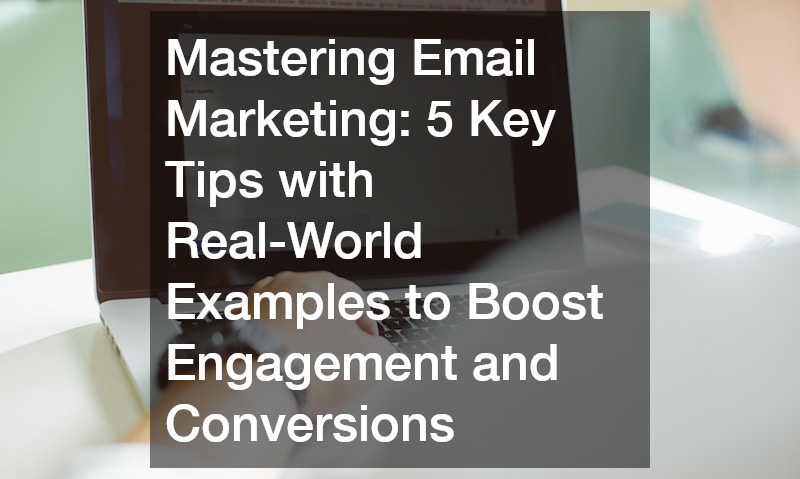

In the fast-paced world of digital marketing, email remains a powerful tool for engaging with audiences and driving sales. It is an essential part of a comprehensive marketing strategy, providing businesses with the ability to reach large audiences effectively. Many companies partner with an email marketing agency to leverage their expertise in optimizing campaigns. Despite the rise of social media and instant messaging, emails continue to offer unrivaled benefits, such as cost-effectiveness, scalability, and personal connection.
This article provides five key tips to help you master email marketing, illustrated with real-world examples to help boost your engagement and conversion rates.
How Can I Improve My Email Open Rates?
Your email open rate is a crucial metric that influences the overall success of your email marketing campaign. The first step in improving open rates is crafting compelling subject lines. A subject line is the first impression your email makes, and it determines whether a subscriber will bother to read the content. For instance, using curiosity or a question can intrigue users, leading them to open the email to learn more. Phrases like “Unlock Your Exclusive Offer” or “Are You Ready for a Surprise?” are designed to pique interest and encourage opens.
Optimizing send times is another effective strategy for enhancing your open rates. Research suggests that emails sent during the late morning or early afternoon typically see higher open rates, as recipients are more likely to check their emails during their lunch breaks or post-lunch work routines. Testing various send times and analyzing the results can help you determine the most effective times to reach your audience. Additionally, different segments of your audience may have different habits, so understanding these nuances can further optimize engagement.
Ensuring mobile responsiveness is also key to improving open rates. With the growing use of smartphones, a majority of emails are now opened on mobile devices. If your email design isn’t mobile-friendly, it may deter recipients from opening or fully engaging with your content. Tools and design templates are available to ensure your emails look great on both large and small screens, reducing friction and enhancing the likelihood of strong open rates. For example, using a single-column layout and ensuring image text spacing can improve readability on mobile devices.
What Are the Best Practices for Personalizing Email Content?
Personalized emails can significantly elevate user engagement. One effective personalization strategy is leveraging subscriber data to tailor your content. For instance, using the recipient’s first name in the subject line or body of the email can create a sense of direct communication. Furthermore, analyzing past purchase behavior or browsing history allows you to recommend relevant products or services, increasing the likelihood of conversion. The more data points you can effectively use, the more personalized and engaging the email will be.
Segmenting your audience based on various criteria—such as demographics, purchase history, or engagement levels—enables more targeted and effective communication. By creating specific segments, you can deliver tailored content that resonates with each group’s unique needs and preferences. For example, sending different promotional offers to new customers versus loyal, repeat customers can optimize relevance and responsiveness. A segmented approach ensures that messages are pertinent and increase the probability of driving action.
Utilizing dynamic content is another powerful way to personalize email interactions. Dynamic content allows you to automatically customize certain sections of your emails in real-time based on the individual recipient’s characteristics. For example, online retailers might use dynamic images to showcase products that a specific customer has previously viewed or similar items they might be interested in. This kind of customization shows users that you understand their preferences and can meet their needs, thus fostering brand loyalty and boosting conversions.
How Can I Increase My Email Conversion Rates?
Conversion rates are the pinnacle of email marketing success. Creating strong calls-to-action (CTAs) is crucial for guiding recipients towards desired actions. A well-crafted CTA clearly communicates what the reader should do next, whether it’s making a purchase, downloading a resource, or signing up for a webinar. Effective CTAs are typically succinct and compelling, often incorporating actionable language like “Get Started Today” or “Claim Your Free Trial Now.” Positioning the CTA prominently within the email and including it multiple times can also enhance conversion potential.
Designing visually appealing emails is essential for capturing attention and encouraging interaction. An effective email combines appealing visuals with engaging content, balancing text and imagery to create a coherent flow. Use colors that align with your brand identity and design elements that draw the reader’s eye to important information and CTAs. Incorporating customer testimonials or user-generated images can also lend authenticity and encourage action, as these elements help build trust and provide social proof.
A/B testing different elements of your email campaigns allows you to identify what works best with your audience, ultimately maximizing conversions. This process involves creating two variants (A and B) of a particular element—such as subject lines, CTAs, or email layouts—and testing these versions on segments of your audience. By analyzing which variant performs better in terms of engagement or conversion, you can implement the more effective approach across your entire campaign. Consistent testing and analysis are key to continuously refining your email strategy and ensuring optimal results.
Conclusion
By implementing these five key tips and learning from real-world examples, you can significantly enhance your email marketing strategy. Working with an email marketing agency can further amplify your efforts, as they bring expertise and resources that can boost engagement and drive conversions. Mastering the art of email marketing will not only contribute to your business’s success but also create a tailored approach that resonates with your audience. Focusing on open rates, personalization, and conversion techniques creates a comprehensive approach that addresses every stage of the email marketing funnel. With dedication and strategic planning, you will be equipped to utilize email as a formidable tool in your digital marketing arsenal, achieving tangible results and sustained growth.



